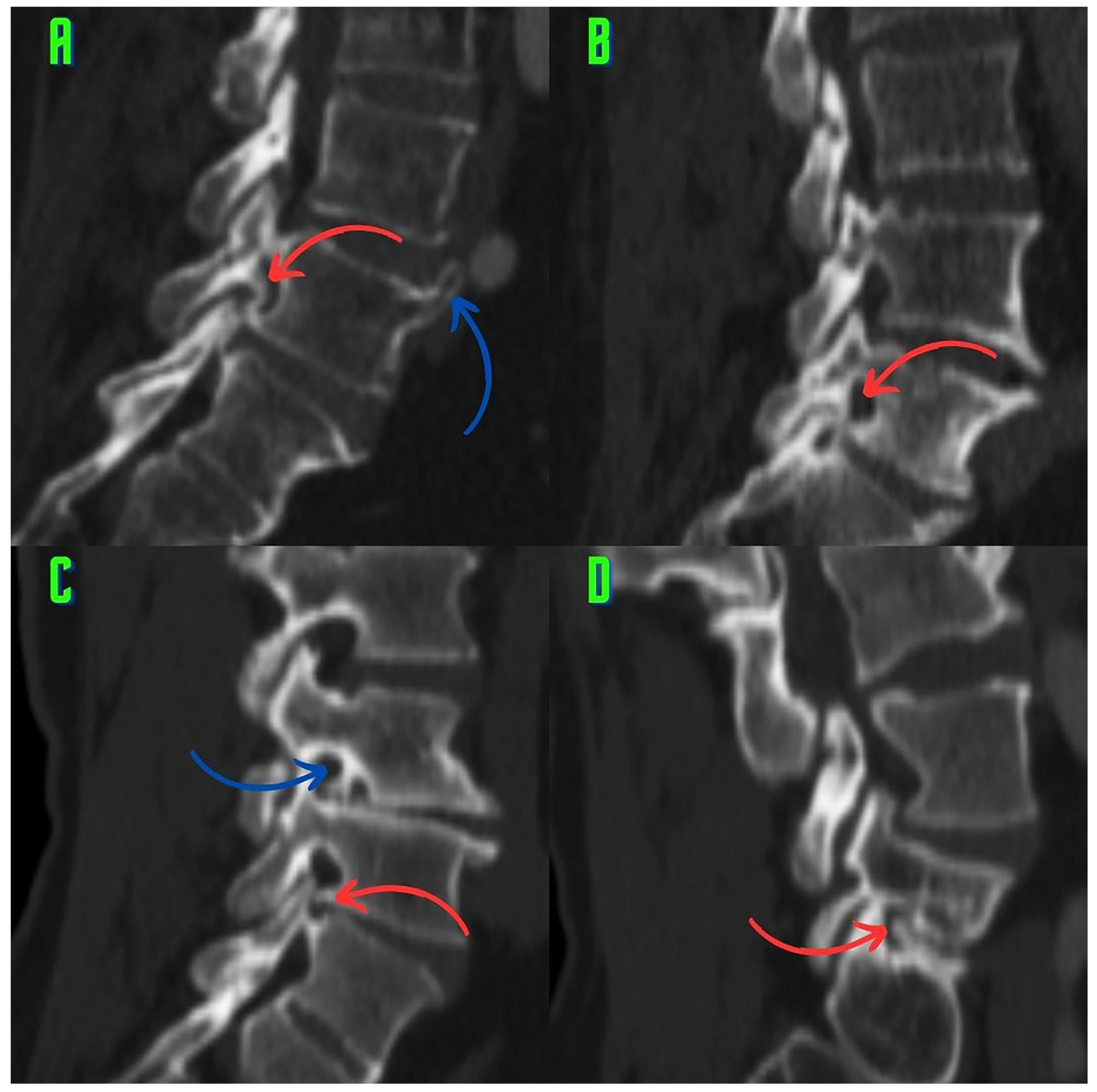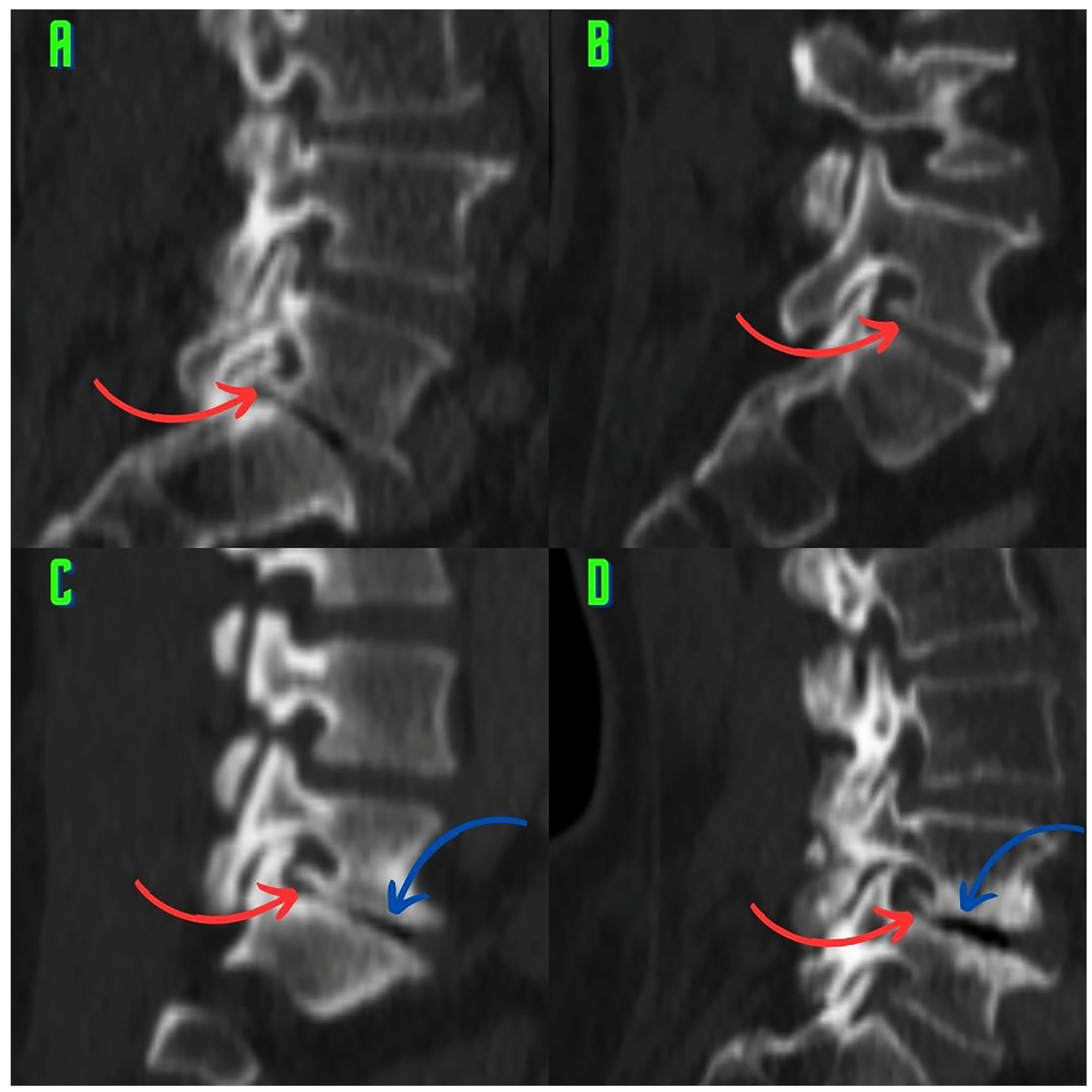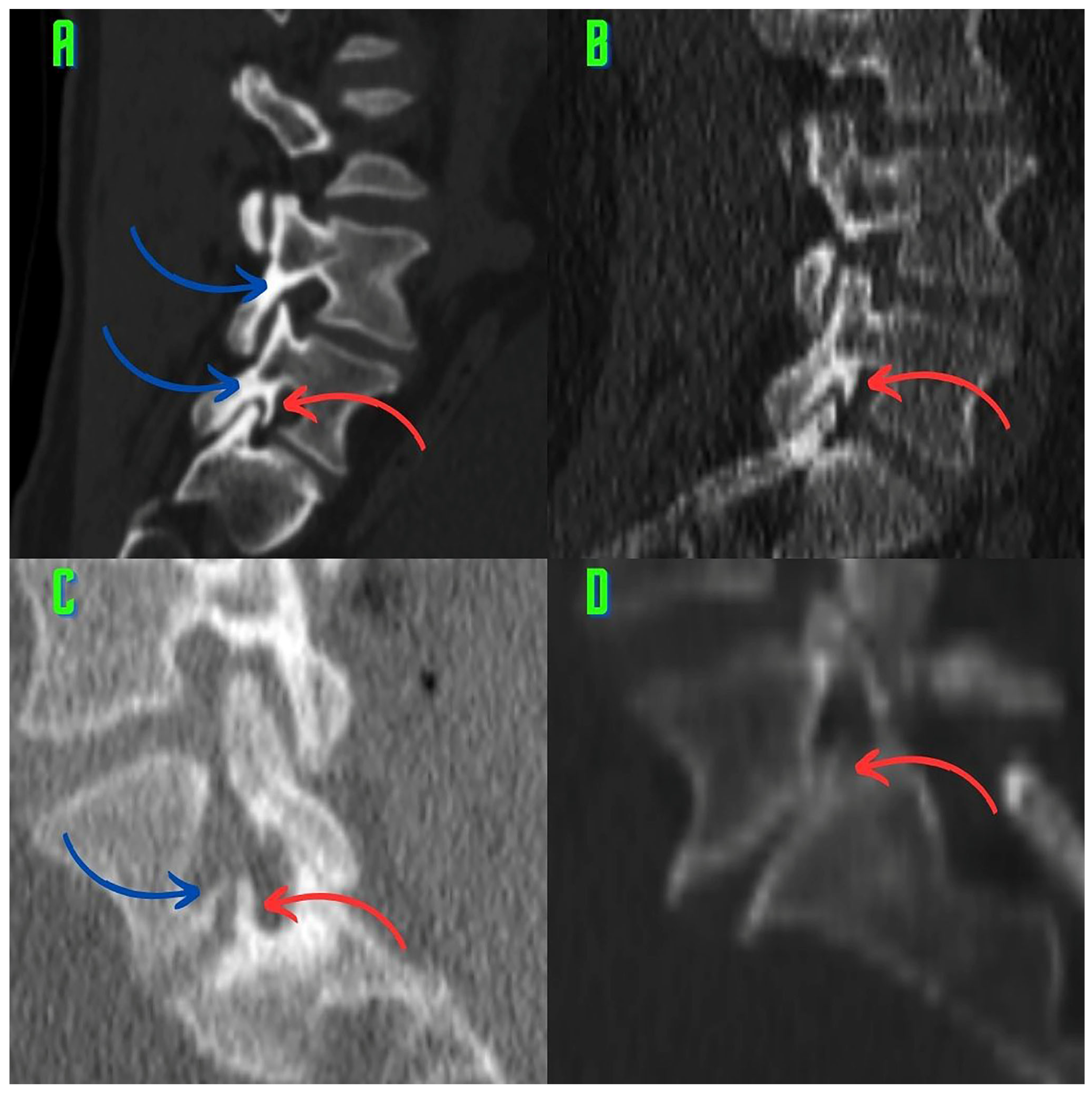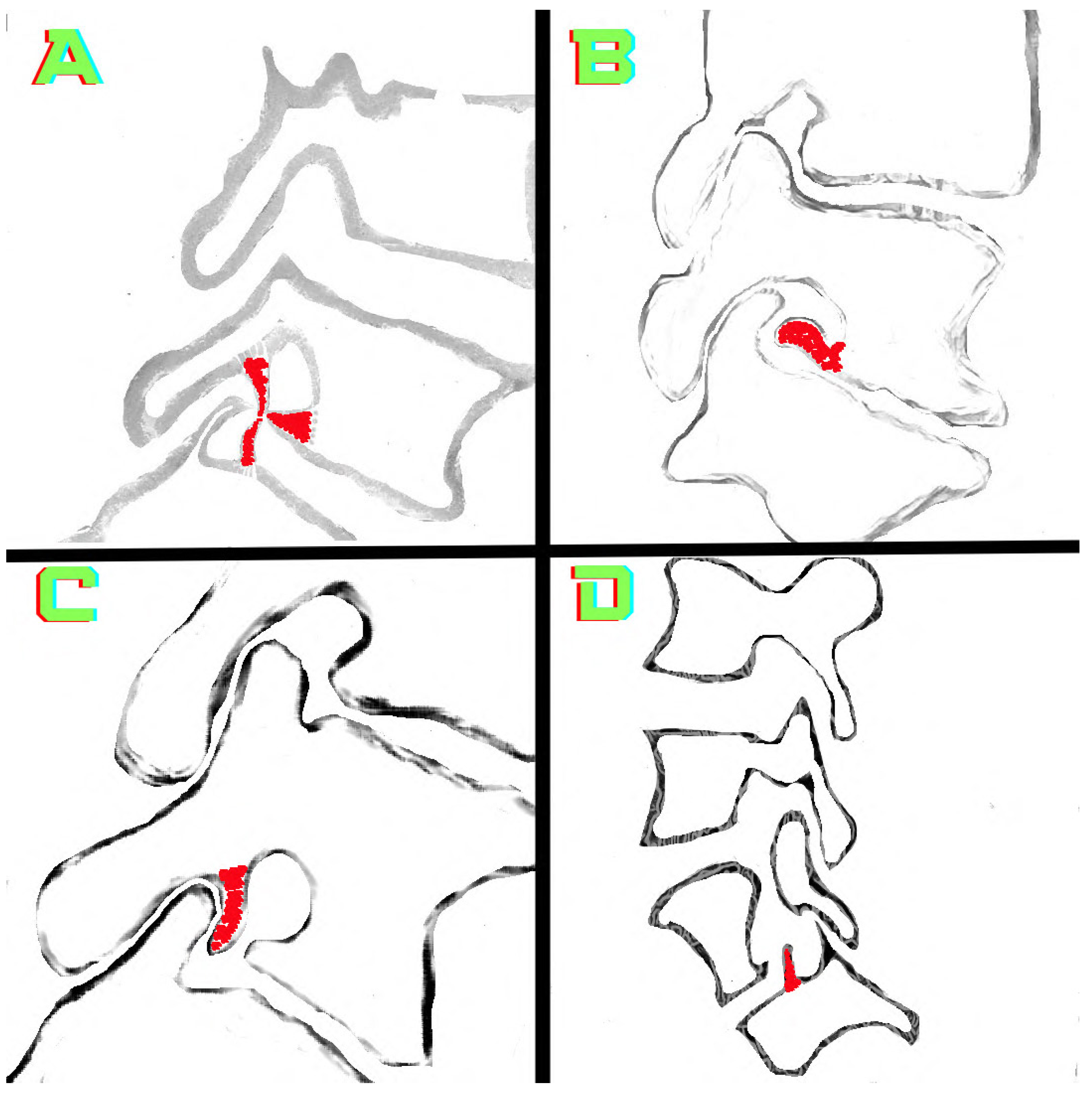Classification of Osteophytes Occurring in the Lumbar Intervertebral Foramen
Abstract
:1. Introduction
2. Materials and Methods
2.1. Patient Population
2.2. Inclusion and Exclusion Criteria
2.3. Image Analysis and Research Methods
2.4. Statistical Analysis
3. Results
4. Discussion
4.1. Osteophytes and Facet Osteoarthritis
4.2. Potential Effect of Osteophytes on Biomechanics
4.3. Osteophytes and Foraminal Stenosis
4.4. Limitations of this Study
5. Conclusions
Author Contributions
Funding
Institutional Review Board Statement
Informed Consent Statement
Data Availability Statement
Acknowledgments
Conflicts of Interest
Abbreviations
References
- Gkasdaris, G.; Kapetanakis, S. Clinical anatomy and significance of the lumbar intervertebral foramen: A review. J. Anat. Soc. India 2015, 64, 166–173. [Google Scholar] [CrossRef]
- Yan, S.; Zhang, Y.; Wang, K.; Han, Y.; Zhu, K.; He, F.; Tan, J. Three-Dimensional Morphological Characteristics of Lower Lumbar Intervertebral Foramen with Age. BioMed Res. Int. 2018, 2018, 8157061. [Google Scholar] [CrossRef]
- Wong, S.H.J.; Chiu, K.Y.; Yan, C.H. Osteophytes. J. Orthop. Surg. 2016, 24, 403–410. [Google Scholar] [CrossRef]
- GBD 2017 Disease and Injury Incidence and Prevalence Collaborators. Global, regional, and national incidence, prevalence, and years lived with disability for 354 diseases and injuries for 195 countries and territories, 1990–2017: A systematic analysis for the Global Burden of Disease Study 2017. Lancet 2018, 392, 1789–1858. [Google Scholar] [CrossRef]
- Lambeek, L.C.; van Tulder, M.W.; Swinkels, I.C.; Koppes, L.L.; Anema, J.R.; van Mechelen, W. The Trend in Total Cost of Back Pain in the Netherlands in the Period 2002 to 2007. Spine 2011, 36, 1050–1058. [Google Scholar] [CrossRef]
- Chamoro, M.; de Luca, K.; Ozbulut, O.; Oei, E.H.G.; Vleggeert-Lankamp, C.L.A.; Koes, B.W.; Bierma-Zeinstra, S.M.A.; Chiarotto, A. Association between clinical findings and the presence of lumbar spine osteoarthritis imaging features: A systematic review. Osteoarthr. Cartil. 2023, 31, 1158–1175. [Google Scholar] [CrossRef] [PubMed]
- Borenstein, D. Does osteoarthritis of the lumbar spine cause chronic low back pain? Curr. Pain Headache Rep. 2004, 8, 512–517. [Google Scholar] [CrossRef]
- Goode, A.P.; Cleveland, R.J.; George, S.Z.; Schwartz, T.A.; Kraus, V.B.; Renner, J.B.; Gracely, R.H.; DeFrate, L.E.; Hu, D.; Jordan, J.M.; et al. Predictors of Lumbar Spine Degeneration and Low Back Pain in the Community: The Johnston County Osteoarthritis Project. Arthritis Care Res. 2021, 74, 1659–1666. [Google Scholar] [CrossRef] [PubMed]
- Schofferman, J.; Reynolds, J.; Herzog, R.; Covington, E.; Dreyfuss, P.; O’Neill, C. Failed back surgery: Etiology and diagnostic evaluation. Spine J. 2003, 3, 400–403. [Google Scholar] [CrossRef] [PubMed]
- Gellhorn, A.C.; Katz, J.N.; Suri, P. Osteoarthritis of the spine: The facet joints. Nat. Rev. Rheumatol. 2013, 9, 216–224. [Google Scholar] [CrossRef]
- Rohen, J.W.; Yokochi, C.; Lütjen-Drecoll, E. Color Atlas of Anatomy: A Photographic Study of the Human Body; Schattauer: Stuttgart, Germany, 2006. [Google Scholar]
- Kang, Y.-M.; Choi, W.-S.; Pickar, J.G. Electrophysiologic Evidence for an Intersegmental Reflex Pathway Between Lumbar Paraspinal Tissues. Spine 2002, 27, E56–E63. [Google Scholar] [CrossRef] [PubMed]
- Schwarzer, A.C.; Aprill, C.N.; Derby, R.; Fortin, J.; Kine, G.; Bogduk, N. Clinical Features of Patients with Pain Stemming from the Lumbar Zygapophysial Joints. Is the lumbar facet syndrome a clinical entity? Spine 1994, 19, 1132–1137. [Google Scholar] [CrossRef] [PubMed]
- Pathria, M.; Sartoris, D.J.; Resnick, D. Osteoarthritis of the facet joints: Accuracy of oblique radiographic assessment. Radiology 1987, 164, 227–230. [Google Scholar] [CrossRef] [PubMed]
- Fujiwara, A.; Tamai, K.; Yamato, M.; An, H.S.; Yoshida, H.; Saotome, K.; Kurihashi, A. The relationship between facet joint osteoarthritis and disc degeneration of the lumbar spine: An MRI study. Eur. Spine J. 1999, 8, 396–401. [Google Scholar] [CrossRef]
- Taylor, J.R.; Twomey, L.T. Structure and Function of Lumbar Zygapophyseal (facet) Joints: A Review. J. Orthop. Med. 1992, 14, 71–78. [Google Scholar] [CrossRef]
- Kettler, A.; Wilke, H.-J. Review of existing grading systems for cervical or lumbar disc and facet joint degeneration. Eur. Spine J. 2005, 15, 705–718. [Google Scholar] [CrossRef] [PubMed]
- Putz, R. The functional morphology of the superior articular processes of the lumbar vertebrae. J. Anat. 1985, 143, 181–187. [Google Scholar] [PubMed]
- Yang, K.H.; King, A.I. Mechanism of Facet Load Transmission as a Hypothesis for Low-Back Pain. Spine 1984, 9, 557–565. [Google Scholar] [CrossRef] [PubMed]
- Vernon-Roberts, B.; Pirie, C.J. Healing trabecular microfractures in the bodies of lumbar vertebrae. Ann. Rheum. Dis. 1973, 32, 406–412. [Google Scholar] [CrossRef]
- Wang, J.; Yang, X. Age-Related Changes in the Orientation of Lumbar Facet Joints. Spine 2009, 34, E596–E598. [Google Scholar] [CrossRef]
- Kim, W.; Porrino, J.A.; Hood, K.A.; Chadaz, T.S.; Klauser, A.S.; Taljanovic, M.S. Clinical Evaluation, Imaging, and Management of Adolescent Idiopathic and Adult Degenerative Scoliosis. Curr. Probl. Diagn. Radiol. 2019, 48, 402–414. [Google Scholar] [CrossRef] [PubMed]
- Goel, A. ‘Only fixation’ as rationale treatment for spinal canal stenosis. J. Craniovertebral Junction Spine 2011, 2, 55–56. [Google Scholar] [CrossRef] [PubMed]
- Goel, A. Facet distraction spacers for treatment of degenerative disease of the spine: Rationale and an alternative hypothesis of spinal degeneration. J. Craniovertebral Junction Spine 2010, 1, 65–66. [Google Scholar] [CrossRef] [PubMed]
- Kozanek, M.; Wang, S.; Passias, P.G.; Xia, Q.; Li, G.; Bono, C.M.; Wood, K.B.; Li, G. Range of Motion and Orientation of the Lumbar Facet Joints In Vivo. Spine 2009, 34, E689–E696. [Google Scholar] [CrossRef]
- Wilke, H.; Neef, P.; Caimi, M.; Hoogland, T.; Claes, L.E. New In Vivo Measurements of Pressures in the Intervertebral Disc in Daily Life. Spine 1999, 24, 755–762. [Google Scholar] [CrossRef] [PubMed]
- Nachemson, A.L. Disc Pressure Measurements. Spine 1981, 6, 93–97. [Google Scholar] [CrossRef] [PubMed]
- Goel, A. Vertical facetal instability: Is it the point of genesis of spinal spondylotic disease? J. Craniovertebral Junction Spine 2015, 6, 47–48. [Google Scholar] [CrossRef] [PubMed]
- Inoue, N.; Orías, A.A.E.; Segami, K. Biomechanics of the lumbar facet joint, Spine surgery and related research. Spine Surg. Relat. Res. 2019, 4, 1–7. [Google Scholar] [CrossRef] [PubMed]
- Dunlop, R.B.; Adams, M.A.; Hutton, W.C. Disc space narrowing and the lumbar facet joints. J. Bone Jt. Surg. 1984, 66, 706–710. [Google Scholar] [CrossRef]
- Prasad, P.; King, A.I.; Ewing, C.L. The Role of Articular Facets During +Gz Acceleration. J. Appl. Mech. 1974, 41, 321–326. [Google Scholar] [CrossRef]
- Gorniak, G.; Conrad, W. Lower lumbar facet joint complex anatomy. Austin. J. Anat. 2015, 2, 1–8. [Google Scholar]
- Ivicsics, M.; Bishop, N.; Püschel, K.; Morlock, M.; Huber, G. Increase in facet joint loading after nucleotomy in the human lumbar spine. J. Biomech. 2014, 47, 1712–1717. [Google Scholar] [CrossRef] [PubMed]
- Ianuzzi, A.; Little, J.S.; Chiu, J.B.; Baitner, A.; Kawchuk, G.; Khalsa, P.S. Human lumbar facet joint capsule strains: I. During physiological motions. Spine J. 2004, 4, 141–152. [Google Scholar] [CrossRef]
- Claeson, A.A.; Barocas, V.H. Computer simulation of lumbar flexion shows shear of the facet capsular ligament. Spine J. 2016, 17, 109–119. [Google Scholar] [CrossRef] [PubMed]
- Jenis, L.G.; An, H.S. Spine update: Lumbar foraminal stenosis. Spine 2000, 25, 389–394. [Google Scholar] [CrossRef] [PubMed]
- Lee, S.; Lee, J.W.; Yeom, J.S.; Kim, K.-J.; Kim, H.-J.; Chung, S.K.; Kang, H.S. A Practical MRI Grading System for Lumbar Foraminal Stenosis. Am. J. Roentgenol. 2010, 194, 1095–1098. [Google Scholar] [CrossRef] [PubMed]
- Attias, N.; Hayman, A.; Hipp, J.A.; Noble, P.; Esses, S.I. Assessment of magnetic resonance imaging in the diagnosis of lumbar spine foraminal stenosis—A surgeon’s perspective. Clin. Spine Surg. 2006, 19, 249–256. [Google Scholar] [CrossRef]
- Murata, S.; Takami, M.; Iwasaki, H.; Hashizume, H.; Yukawa, Y.; Minamide, A.; Nakagawa, Y.; Tsutsui, S.; Okada, M.; Nagata, K.; et al. Outcomes and Vertebral Osteophytes and Bulging Intervertebral Discs Occupancy as a Decision-Making Tool for Surgical Success in Patients Undergoing Microendoscopic Foraminotomy for Lumbar Foraminal Stenosis. World Neurosurg. 2024, 182, e570–e578. [Google Scholar] [CrossRef]




| Variable | Group | Frequency | Percentage |
|---|---|---|---|
| Gender | Male | 697 | 56.9 |
| Female | 527 | 43.1 | |
| L5–S1 | None | 1025 | 83.7 |
| Left | 65 | 5.3 | |
| Right | 57 | 4.7 | |
| Right and Left | 77 | 6.3 | |
| L4–L5 | None | 1151 | 94.0 |
| Left | 27 | 2.2 | |
| Right | 27 | 2.2 | |
| Right and Left | 19 | 1.6 | |
| Total | 1224 | 100.0 | |
| Variable | Mean ± SD | Min–Max | |
| Age | 47.75 ± 19.03 | 18–109 | |
| Variable | Group | n/% | L5–S1 | Total | Test Value a | p-Value | |
|---|---|---|---|---|---|---|---|
| Absent | Present | ||||||
| L4–L5 | Absent | n | 957 | 176 | 1151 | 12,094 | <0.001 * |
| % | 95.1% | 88.4% | 94.0% | ||||
| Present | n | 50 | 23 | 73 | |||
| % | 4.9% | 11.6% | 6.0% | ||||
| Total | n | 1025 | 199 | 1224 | |||
| % | 100.0% | 100.0% | 100.0% | ||||
| Variable | Group | n/% | Gender | Total | Test Value a | p-Value | |
|---|---|---|---|---|---|---|---|
| Male | Female | ||||||
| % | 10.1% | 10.6% | 10.3% | ||||
| L5–S1 | Absent | n | 589 | 436 | 1025 | 3259 | 0.353 |
| % | 84.5% | 82.7% | 83.7% | ||||
| Left | n | 33 | 32 | 65 | |||
| % | 4.7% | 6.1% | 5.3% | ||||
| Right | n | 36 | 21 | 57 | |||
| % | 5.2% | 4.0% | 4.7% | ||||
| Right and Left (Bilateral) | n | 39 | 38 | 77 | |||
| % | 5.6% | 7.2% | 6.3% | ||||
| L4–L5 | Absent | n | 654 | 497 | 1151 | 1837 | 0.607 |
| % | 93.8% | 94.3% | 94.0% | ||||
| Left | n | 16 | 11 | 27 | |||
| % | 2.3% | 2.1% | 2.2% | ||||
| Right | n | 18 | 9 | 27 | |||
| % | 2.6% | 1.7% | 2.2% | ||||
| Right and Left (Bilateral) | n | 9 | 10 | 19 | |||
| % | 1.3% | 1.9% | 1.6% | ||||
| Total | n | 697 | 527 | 1224 | |||
| % | 100.0% | 100.0% | 100.0% | ||||
| Variable | Group | Mean ± SD | M | Min–Max | Test Value | p-Value | Difference |
|---|---|---|---|---|---|---|---|
| Left L5–S1 | Absent | 46.01 ± 18.6 | 43.00 | 18–109 | 42,068.000 a | <0.001 * | Present |
| Present | 61.08 ± 16.91 | 61.00 | 19–101 | ||||
| Right L5–S1 | Absent | 45.94 ± 18.37 | 43.00 | 18–109 | 37,973.000 a | <0.001 * | Present |
| Present | 62.52 ± 17.95 | 63.00 | 20–101 | ||||
| L5–S1 | Absent | 45.17 ± 18.22 | 42.00 | 18–109 | 112,789 b | <0.001 * | 1 and 2, 1 and 3, 1 and 4 |
| Left | 58.08 ± 16.36 | 56.00 | 19–93 | ||||
| Right | 61.05 ± 19.14 | 62.00 | 20–99 | ||||
| Right and Left | 63.61 ± 17.06 | 64.00 | 20–101 | ||||
| Left L4–L5 | Absent | 47.00 ± 18.77 | 44.00 | 18–109 | 11,234.000 a | <0.001 * | Present |
| Present | 67.07 ± 15.25 | 66.50 | 20–92 | ||||
| Right L4–L5 | Absent | 47.09 ± 18.09 | 44.00 | 18–109 | 12,662.500 a | <0.001 * | Present |
| Present | 64.7 ± 14.00 | 62.00 | 33–92 | ||||
| L4–L5 | Absent | 46.63 ± 18.71 | 44.00 | 18–109 | 65,559 b | <0.001 * | 1 and 2, 1 and 3, 1 and 4 |
| Left | 66.85 ± 16.28 | 69.00 | 20–87 | ||||
| Right | 62.81 ± 13.9 | 63.00 | 33–87 | ||||
| Right and Left | 67.37 ± 14.07 | 61.00 | 38–92 |
Disclaimer/Publisher’s Note: The statements, opinions and data contained in all publications are solely those of the individual author(s) and contributor(s) and not of MDPI and/or the editor(s). MDPI and/or the editor(s) disclaim responsibility for any injury to people or property resulting from any ideas, methods, instructions or products referred to in the content. |
© 2024 by the authors. Licensee MDPI, Basel, Switzerland. This article is an open access article distributed under the terms and conditions of the Creative Commons Attribution (CC BY) license (https://creativecommons.org/licenses/by/4.0/).
Share and Cite
Taçyıldız, A.E.; İnceoğlu, F. Classification of Osteophytes Occurring in the Lumbar Intervertebral Foramen. Tomography 2024, 10, 618-631. https://doi.org/10.3390/tomography10040047
Taçyıldız AE, İnceoğlu F. Classification of Osteophytes Occurring in the Lumbar Intervertebral Foramen. Tomography. 2024; 10(4):618-631. https://doi.org/10.3390/tomography10040047
Chicago/Turabian StyleTaçyıldız, Abdullah Emre, and Feyza İnceoğlu. 2024. "Classification of Osteophytes Occurring in the Lumbar Intervertebral Foramen" Tomography 10, no. 4: 618-631. https://doi.org/10.3390/tomography10040047
APA StyleTaçyıldız, A. E., & İnceoğlu, F. (2024). Classification of Osteophytes Occurring in the Lumbar Intervertebral Foramen. Tomography, 10(4), 618-631. https://doi.org/10.3390/tomography10040047








